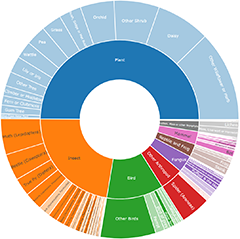Boletes - Fleshy texture, stems central (more-or-less)
The fungi in this sub-group produce fruitbodies that, until you look below the cap could be mistaken for mushrooms. However, instead of gills below the cap there are pores. In fungal field guides you will find these fungi referred to collectively as boletes. In boletes the cap is quite thick in relation to its diameter. In some boletes the flesh or pores may turn blue when damaged, in others there is no colour change and bolete identification keys ask about this.
In the following hints you see examples of useful identification features and a few of the more commonly seen genera in which at least some species (not necessarily all) show those features.
Hints
Cap over 30 cm in diameter: Phlebopus.
Very soft texture, like marshmallow: Fistulinella.
Red cap, yellow pores: Boletellus.
Growing near pine trees: Suillus.
Growing near birch trees: Leccinum.
Stem deeply pitted, somewhat honeycomb-like: Austroboletus.
Top contributors
- LisaH 47
- Teresa 46
- trevorpreston 26
- TimL 24
- Mike 23
- Csteele4 19
- AlisonMilton 18
- Clarel 17
- Aussiegall 12
- AaronClausen 12
Top moderators
- Heino1 149
- Heinol 130
- Teresa 72
- Pam 56
- Csteele4 37
- MichaelMulvaney 34
- Heino 19
- CanberraFungiGroup 9
- JTran 8
- KenT 2







